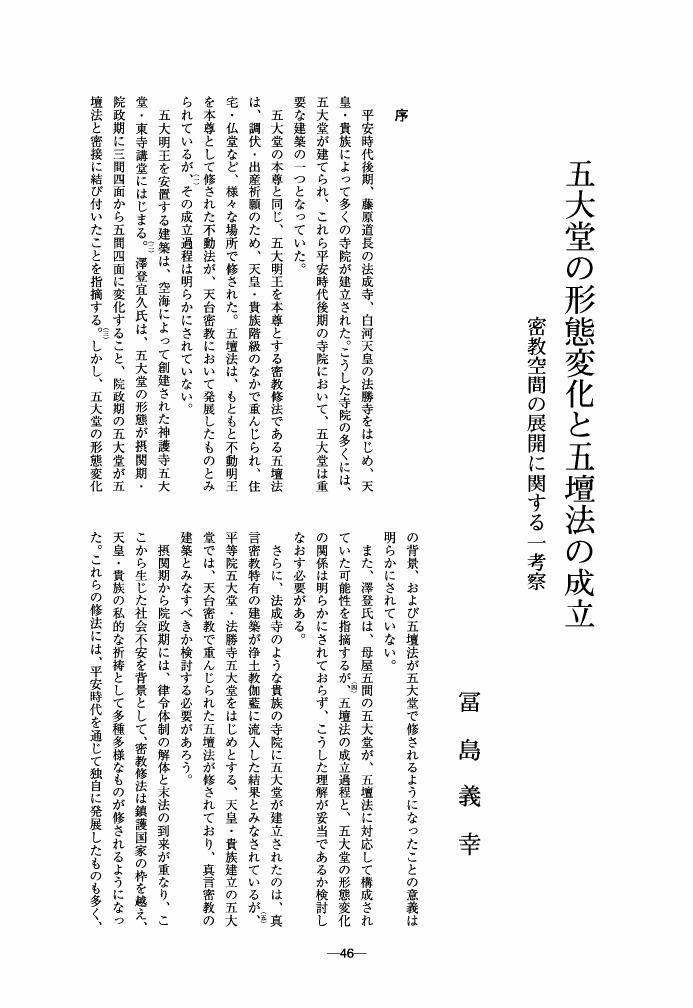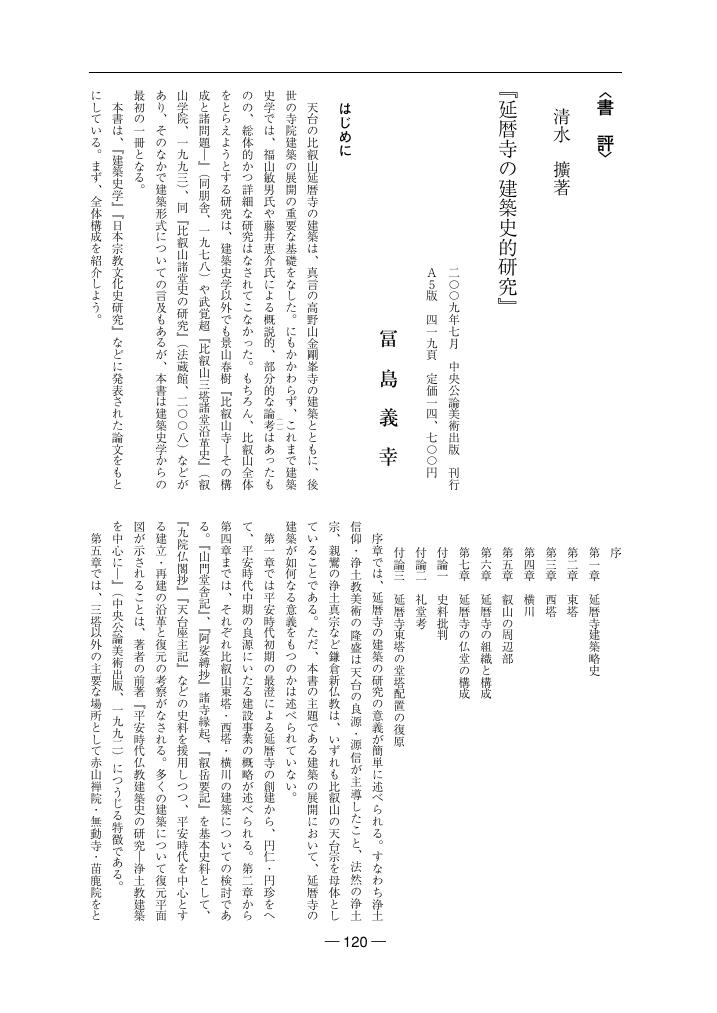5 0 0 0 OA 五大堂の形態変化と五壇法の成立 密教空間の展開に関する一考察
- 著者
- 冨島 義幸
- 出版者
- 建築史学会
- 雑誌
- 建築史学 (ISSN:02892839)
- 巻号頁・発行日
- vol.33, pp.46-83, 1999 (Released:2018-09-13)
3 0 0 0 OA 建築・聖教・美術から見た新義・古義を包括的に捉える日本密教史の再構築
日本の密教寺院に関しては、事相中心の古義真言教団と、教相中心の新義教団という図式的区分がある。古義教団の醍醐寺では、灌頂や諸尊法の伝授だけではなく、教相聖教の作成・書写・修学・法会が行われていた。一方の新義教団の寺院の実態は、これまで史料が乏しかったが、既往研究を踏まえつつ、智積院所蔵史料を調査することによって一挙に実態が明瞭となった。これらの史料蒐集の結果、高野山・醍醐寺・根来寺、さらに周辺の多くの地方寺院の間での聖教の書写・貸借を踏まえた修学・伝授のネットワークが確認され、事相・教相を総合的に受容する中世密教寺院の実態が明らかになった。新義・古義の教団理解にも修正を加えることとなった。
2 0 0 0 OA 清水擴著『延暦寺の建築史的研究』
- 著者
- 冨島 義幸
- 出版者
- 建築史学会
- 雑誌
- 建築史学 (ISSN:02892839)
- 巻号頁・発行日
- vol.55, pp.120-128, 2010 (Released:2018-06-28)
1 0 0 0 中世の浄土信仰とその建築造形―密教の影響をめぐって―
古代・中世の浄土信仰にもとづく建築のなかでも、本年度は中尊寺金色堂を中心に空間構成理念の調査・研究をおこなった。また、阿弥陀堂など浄土信仰の建築の本尊となる阿弥陀如来像をはじめとする仏像の調査をおこない、そこにこめられた密教的意味を明らかにした。主たる成果は以下のとおりである。1. 中尊寺金色堂における密教の影響:金色堂の四天柱には密教の尊像が描かれ、これまでこられの尊像は浄土教の阿弥陀四十八願にもとづくとする説と、密教の胎蔵界曼荼羅にもとづくとする説の二説があったが、五十二身像という密教の阿弥陀曼荼羅にもとづくとする新たな説を提示した。また、従来、金色堂の須弥壇に安置された奥州藤原氏三代の遺体は、東北地方のミイラ信仰と結びつけてとらえられてきたが、棺におさめられた曳覆曼荼羅などの副葬品を調査・検討し、同時代の京都の貴族と同じ密教による葬送であったとする説を提示した。この成果は冨島義幸「中尊寺金色堂再考」(入間田宣夫編『兵たちの時代III兵たちの極楽浄土』高志書院)として発表した。2. 仏像と密教修法:仏教建築の本尊として安置された仏像は、その建築空間の宗教的な意味を決定づける、きわめて重要な要素である。阿弥陀如来像や観音菩薩像など、いわゆる浄土教にもとづく造像とされてきた仏像でも、その胎内にその像の種子を書いた月輪が納入されるなど、密教の要素が認められることが指摘されてきたが、その具体的な意味については明確にされていなかった。本年度は、仏像胎内の月輪や内部に直接書き付けられた本尊種子について、現存作品・記録・聖教を総合的に調査・検討し、こうした月輪種子が密教修法にもとづくものであること、すなわちこうした月輪種子を胎内におさめる仏像が、密教修法の本尊となっていたことを明らかにした。本研究の成果は冨島義幸「修法と仏像-胎内の月輪種子を手がかりとして-」として発表した。
- 著者
- 冨島 義幸
- 出版者
- 密教図像学会
- 雑誌
- 密教図像 (ISSN:02873176)
- 巻号頁・発行日
- no.39, pp.巻頭1p,37-54, 2020-12
1 0 0 0 寺院建築史(古代・中世)
- 著者
- 冨島 義幸
- 出版者
- 建築史学会
- 雑誌
- 建築史学 (ISSN:02892839)
- 巻号頁・発行日
- vol.30, pp.98-122, 1998
1 0 0 0 OA 阿弥陀堂における両界曼荼羅空間の展開
- 著者
- 冨島 義幸
- 出版者
- 日本建築学会
- 雑誌
- 日本建築学会計画系論文集 (ISSN:13404210)
- 巻号頁・発行日
- vol.66, no.544, pp.255-262, 2001-06-30 (Released:2017-02-04)
In the history of Japanese architecture, we considered the Amidado and Jyogyodo halls of the Heian period to be "Western Paradise Architecture". But, we find many elements of esoteric Buddhism in this architecture, and the space of the Hokkai-ji Amidado hall was constructed as a three-dimensional Vajradhatu Mandala. Such Amidado hallsappeared in the middle 12th century through the relationship between retired Emperors and Ninnaji-Omuro. The appearance of such Amidado halls was connected with the extension of the influence of Garbadhatu and Vajradhatu Mandalas upon the space of Buddhist architecture in the late Heian period, and this phenomenon was probably based on the devotion towards Amida Buddha in the Shingon Buddhist sect.
1 0 0 0 平安時代の阿弥陀信仰と密教
- 著者
- 冨島 義幸
- 出版者
- 日本宗教文化史学会
- 雑誌
- 日本宗教文化史研究 = The Journal of Japanese religious and cultural history (ISSN:13428659)
- 巻号頁・発行日
- vol.21, no.2, pp.20-43, 2017-11
- 著者
- 冨島 義幸
- 出版者
- 日本宗教文化史学会
- 雑誌
- 日本宗教文化史研究 = The Journal of Japanese religious and cultural history (ISSN:13428659)
- 巻号頁・発行日
- vol.21, no.1, pp.55-78, 2017-05
- 著者
- 冨島 義幸
- 出版者
- 宮城歴史科学研究会
- 雑誌
- 宮城歴史科学研究 (ISSN:03893227)
- 巻号頁・発行日
- no.60, pp.38-52, 2006-07
1 0 0 0 OA 仏教儀礼の成立と展開に関する総合的研究
本研究は、アジアにおける仏教儀礼の形成と展開、変容をテーマに、さまざまな領域の研究者による共同研究の形式で進められた。参加した研究者はインド学、仏教学、歴史学、人類学、美術史、建築史、宗教学等の分野で、多角的な視点から研究をおこなった。そのための枠組みとして王権論、表象論、空間論、技術論、身体論という5つの研究領域を設定した。とくに顕著な研究成果として灌頂に関する論文集があげられる。代表的な仏教儀礼のひとつである灌頂を取り上げ、その全体像を示すことに成功し、儀礼研究の新たな水平を開いた。また研究の総括として、儀礼と視覚イメージとの関係についての国際シンポジウムを開催した。

